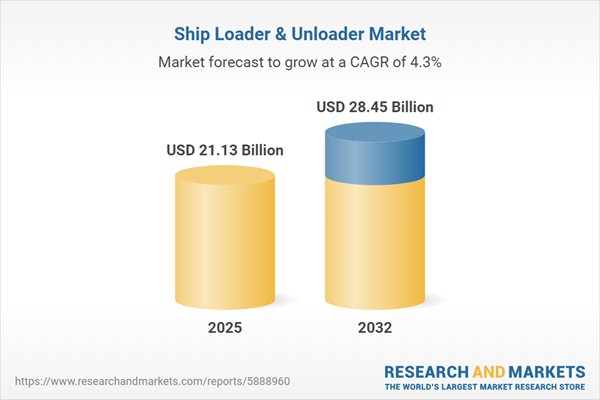Speak directly to the analyst to clarify any post sales queries you may have.
The Ship Loader & Unloader Market is evolving rapidly, driven by shifts in global logistics, technology integration, sustainability goals, and regulatory changes. This report provides senior stakeholders with actionable insights critical for informed decision-making in an increasingly complex bulk materials handling landscape.
Market Snapshot: Ship Loader & Unloader Market
The Ship Loader & Unloader Market grew from USD 20.29 billion in 2024 to USD 21.13 billion in 2025. It is expected to continue growing at a compound annual growth rate (CAGR) of 4.31%, reaching USD 28.45 billion by 2032. This upward trajectory reflects heightened demand for efficient cargo transfer solutions and sustained investments across port infrastructure, technology upgrades, and sustainability compliance worldwide.
Scope & Segmentation
This comprehensive research examines the core dynamics and segmentation shaping the ship loader and unloader sector, delivering clarity across product, application, and geography:
- Product Type: Ship loaders (continuous, grab, telescopic); ship unloaders (pneumatic, screw-type).
- Position: Mobile units; stationary installations.
- Technology: Mechanical systems for heavy-duty operations; pneumatic solutions for lower maintenance and specific cargo needs.
- Load Capacity: High, medium, and low capacity ship loaders to address different operational scales and port sizes.
- Application: Dry bulk handling for granular and mineral commodities; liquid bulk solutions vital for chemical and petroleum sectors.
- End-Use Industry: Agriculture, construction, manufacturing, mining, oil & gas, ports and harbors each exhibiting unique throughput patterns and compliance requirements.
- Regional Coverage:
- Americas: North America (United States, Canada, Mexico); Latin America (Brazil, Argentina, Chile, Colombia, Peru).
- Europe, Middle East & Africa: Europe (United Kingdom, Germany, France, Russia, Italy, Spain, Netherlands, Sweden, Poland, Switzerland); Middle East (UAE, Saudi Arabia, Qatar, Turkey, Israel); Africa (South Africa, Nigeria, Egypt, Kenya).
- Asia-Pacific: China, India, Japan, Australia, South Korea, Indonesia, Thailand, Malaysia, Singapore, Taiwan.
- Profiles of Key Competitors: AMECO Group, Astec Bulk Handling Solutions, AUMUND Fördertechnik, Bedeschi SpA, BEUMER Group, Bruks Siwertell Group, and others actively shaping the landscape through technology, regional expertise, and aftermarket services.
Key Takeaways for Senior Leaders
- High-performance ship loaders and unloaders directly impact port productivity, reducing turnaround times and optimizing global supply chain throughput.
- Integration of IoT-enabled sensors and predictive maintenance platforms is elevating operational reliability and minimizing unplanned equipment downtime across terminals.
- Stricter environmental regulations are accelerating investment in low-emission power systems and advanced dust containment solutions, prompting manufacturers to prioritize sustainable innovation.
- Modular and mobile machinery is gaining adoption, giving port operators flexibility for multi-terminal deployment and efficient adaptation to fluctuating cargo volumes.
- Strategic vendor partnerships and regional sourcing are now essential as competitive differentiation shifts towards agility, digital integration, and compliance with diverse regulatory mandates.
- Demand diversity by product and end-user segment underscores the need for tailored procurement strategies aligned to specific industry cycles and port characteristics.
Tariff Impact: Navigating the 2025 Regulatory Environment
The introduction of new trade tariffs in 2025 has resulted in elevated input costs for steel components and specialized fabrication services. In response, global and regional manufacturers have diversified sourcing strategies, enhanced value engineering initiatives, and established assembly operations in tariff-exempt or free trade areas. These shifts are fortifying supply chain agility and encouraging local production capabilities to mitigate future tariff risks.
Methodology & Data Sources
This report’s foundation is a multi-stage methodology, blending expansive secondary research with targeted stakeholder interviews. Data from industry publications, regulatory filings, and patent databases was triangulated with first-hand insights from manufacturing leaders, port operators, and policy makers. Quantitative results are validated through rigorous cross-referencing of shipment volumes, equipment lifecycles, and independent benchmarking studies.
Why This Report Matters
- Enables leadership to identify actionable opportunities and supply chain risks in the evolving ship loader and unloader market.
- Supports strategic planning with segmented market intelligence tailored to product, technology, and regional variations.
- Helps drive investment decisions in automation, sustainability, and localized sourcing to sustain competitiveness and compliance.
Conclusion
The ship loader and unloader market’s future will be shaped by technology integration, sustainability imperatives, and agile supply strategies. Senior decision-makers who align investments to these priorities position their organizations for lasting advantage amid continued industry transformation.
Additional Product Information:
- Purchase of this report includes 1 year online access with quarterly updates.
- This report can be updated on request. Please contact our Customer Experience team using the Ask a Question widget on our website.
Table of Contents
3. Executive Summary
4. Market Overview
7. Cumulative Impact of Artificial Intelligence 2025
Companies Mentioned
The companies profiled in this Ship Loader & Unloader market report include:- AMECO Group
- Astec Bulk Handling Solutions
- AUMUND Fördertechnik GmbH
- Bedeschi SpA
- BEUMER Group GmbH & Co. KG
- Bruks Siwertell Group
- BVS Bülbüloğlu Vinç San. Tic. A.Ş.
- Bühler AG
- Dalian Huarui Heavy Industry Group Co., Ltd.
- Dana Incorporated
- FLSmidth A/S
- FM Bulk Handling A/S
- IBAU HAMBURG Ingenieurgesellschaft Industriebau mbH
- IHI Corporation
- Jiangsu Tonghui Lifting Equipment Co., Ltd.
- Kawasaki Heavy Industries, Ltd.
- Konecranes PLC
- Liebherr-International Deutschland GmbH
- Loibl Förderanlagen GmbH
- MITSUI MIIKE MACHINERY CO., LTD.
- NEUERO Industrietechnik für Förderanlagen GmbH
- REEL international SAS
- Sandvik AB
- SKE Industries
- SMB International GmbH
- Superior Industries, Inc.
- Taiyuan Heavy Industry Co., Ltd.
- TAKRAF GmbH
- Telestack Limited
- Tenova S.p.A.
- thyssenkrupp AG
- TSK ELECTRÓNICA Y ELECTRICIDAD, S.A.
- Vigan Engineering SA
- Weihua Group
Table Information
| Report Attribute | Details |
|---|---|
| No. of Pages | 196 |
| Published | November 2025 |
| Forecast Period | 2025 - 2032 |
| Estimated Market Value ( USD | $ 21.13 Billion |
| Forecasted Market Value ( USD | $ 28.45 Billion |
| Compound Annual Growth Rate | 4.3% |
| Regions Covered | Global |
| No. of Companies Mentioned | 35 |









